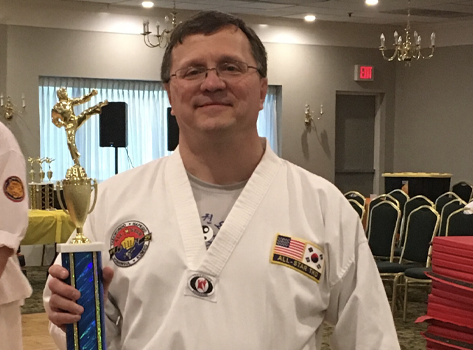When Jim F. started having trouble lifting his left foot, he figured it was related to a high school knee injury. Later, he thought his back was to blame. He never suspected his “foot drop” was due to a brain tumor.
“Foot drop is often caused by arthritic changes or a herniated disc within the lumbar spine,” explains Yaron A. Moshel, MD, PhD, director of the Gerald J. Glasser Brain Tumor Center at Atlantic Health System. “However, it is less well known that you can experience the same symptoms from a large brain tumor that’s affecting the functional area of the brain responsible for leg movement.”
Jim visited his doctor, but his foot problems remained. He continued working as a pharmaceutical salesperson, and one day, during an on-the-job visit to a neurologist’s office, something important happened. The staff noticed how he was walking. They encouraged him to get a magnetic resonance imaging (MRI) scan.
Jim’s MRI showed a large tumor in the center of his brain, known as a falcine and parasagittal meningioma.
Specialized treatment for a complex brain tumor
The good news was that Jim’s brain tumor was not cancerous. The bad news was that it was growing and wrapping around a large vein.
“Jim’s tumor was particularly large and complex,” says Dr. Moshel. “Our chief concern was extracting the tumor safely without damaging the vein or the movement centers of the brain that were already being compromised.”
Dr. Moshel and his team at Morristown Medical Center took a microsurgical approach to Jim’s surgery. With a microscope and special instruments, they carefully separated the mass from the brain. They also used a special type of monitoring to confirm if and how Jim’s leg could move during the procedure.
Jim’s surgery was a huge success. The team removed the entire tumor.
“These kinds of tumors often leave residual tissue that can cause the tumor to come back,” shares Dr. Moshel. “Because we were able to remove all the tumor cells, Jim didn’t need any follow-up radiation therapy.”
From recovery to martial arts champ
After surgery, Jim started physical therapy. Within six months, not only was his leg back to normal, but he felt like an athlete again.
To make the most of the experience, Jim decided to try something new — taekwondo and karate. Now in his 60s, he feels stronger than ever. He regularly competes, and wins, against much younger opponents.
“This entire experience was life-changing,” he says. “To survive a brain tumor, you have to set goals and give recovery all you got. That’s exactly what I did. I wanted to come back stronger than ever. I am where I am today because of Dr. Moshel’s good work, my rehabilitation team’s good work and my dedication to following their guidance with a vengeance.”
Some brain tumors can come back after surgery. But thanks to the Glasser Brain Tumor Center’s long-term follow-up care, Jim knows he’s in the clear.
“Even when we remove a brain tumor completely, they are known to recur, which is why we follow our patients at the Glasser Brain Tumor Center in perpetuity, not just for a year or two,” notes Dr. Moshel. “The relationships we build with patients are enduring and go beyond the hospital walls. We’re all part of a wonderful community, and we’re all in this together.”












